Internal Block Diagram (IBD)
An IBD is a structure diagram showing the internal structure of a block including its ports and relationships in Innoslate.
Using Internal Block Diagrams
| Function | Description |
|---|---|
| Creating Internal Block Diagrams | Using ‘Diagrams View’ in Innoslate, you can create a new ‘Internal Block Diagram’. |
| Internal Block Diagram Constructs | The ‘Internal Block Diagram’ supports three unique diagram constructs: a ‘Block,’ a ‘Port,’ and a ‘Connector.’ |
| Adding a Block | A ‘Block’ construct can be added to an ‘Internal Block Diagram’ via drag-and-drop. |
| Adding a Port | A ‘Port’ construct can be added to an ‘Internal Block Diagram’ via drag-and-drop. |
| Adding a Connector | A ‘Connector’ construct can be added to an ‘Internal Block Diagram’ via drag-and-drop. |
| Removing a Construct | A construct can be easily removed from an ‘Internal Block Diagram.’ |
| Nesting a Block | A ‘Block’ construct can be nested inside another existing ‘Block’ construct within an ‘Internal Block Diagram’ via drag-and-drop. |
| Nesting a Port | A ‘Port’ construct can be nested inside another existing ‘Port’ construct within an ‘Internal Block Diagram’ via drag-and-drop. |
The ‘Internal Block Diagram’ is a structure diagram showing the internal structure of a block including its ports and relationships.

Creating Internal Block Diagrams
Within the ‘Diagrams Dashboard,’ users can create a new diagram by clicking the ‘ New Diagram’ button in the top right corner of the page.

Clicking the ‘ Create Diagram’ button will open the New Diagram dialog where you will be directed through the process of creating a new diagram.
Create an Internal Block Diagram
- Choose Which Type of Diagram to Create
In step 1, select ‘Internal Block Diagram,’ under ‘SysML,’ as your diagram type.

Click the ‘Next’ button.

- Specify New Root Action Information
In step 2, you will be prompted to input a diagram ‘Name,’ ‘Number’ (optional), and ‘Description’ (optional). Then, click the ‘Finish’ button to save and automatically open your new Internal Block Diagram.

Internal Block Diagram Constructs
The ‘Internal Block Diagram‘ supports three unique diagram constructs: a ‘Block,’ a ‘Port,’ and a ‘Connector.’ Each diagram construct is described in more detail below:
-
Block
This construct is used to capture the physical components of a system. In the system model, an Asset entity with a Block label is generated to represent a ‘Block’ construct. In the diagram, this construct is represented as a rounded block containing the name of the ‘Block.’

-
Port
This construct is used to specify the location where ‘Block’ constructs connect. In the system model, a ‘Port’ entity is generated to represent a ‘Port’ construct with the decomposes/decomposed by relationship to a block entity within or above a current level of composition.

-
Connector
This construct is used to capture the relationships between the physical components of a system.
In the system model, a Connector entity is generated to represent a ‘Connector’ construct with a relationship to each of the entities representing the two connected constructs.
In the diagram, this construct is represented as a solid line connecting two ‘Block’ constructs, two ‘Port’ constructs or a combination thereof, and a line label containing the name of the ‘Connector.’ This creates the connects to relationship.
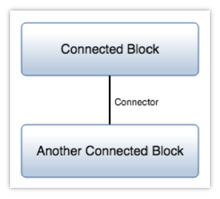
Adding a Block
A ‘Block’ construct can be added to an ‘Internal Block Diagram‘ via drag-and-drop.
- Within an ‘Internal Block Diagram,’ click the ‘Block’ icon in the ‘New’ tab of the left sidebar and continue to hold down the left mouse button.
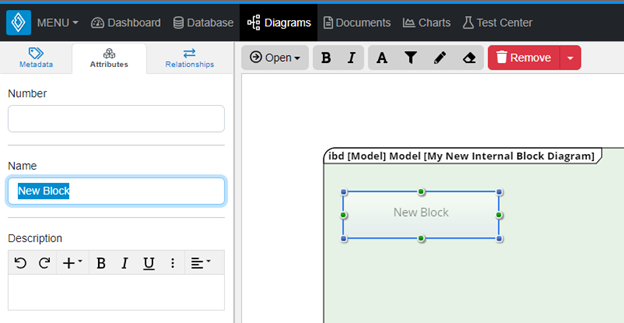
- Drag the ‘Block’ icon over to the adjacent diagram canvas.
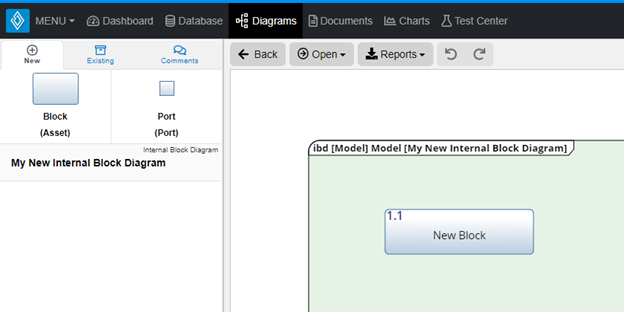
- Release the left mouse button while over the diagram canvas to drop the new ‘Block’ and add it to the diagram. The ‘Block’ will automatically snap to the nearest invisible grid intersection.
Notice the ‘Block’ stays selected once it has been dropped. Since it is selected, the toolbar changes to include buttons for functions that can be used on the construct. The sidebar also changes to include additional ‘Metadata,’ ‘Attributes,’ and ‘Relationships’ tabs.
- Once added to the diagram, enter a meaningful ‘Name’ for your new ‘Block’ via the ‘Attributes’ tab of the left sidebar (focused automatically for convenience).
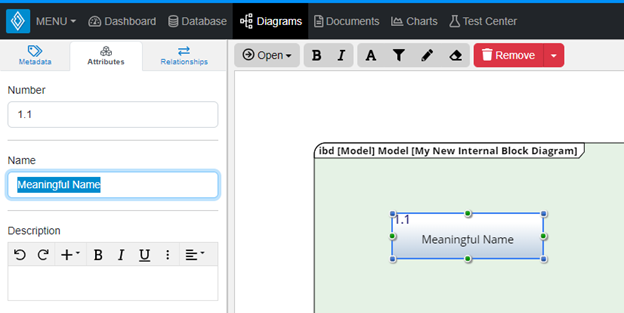
- Click the ‘Save’ button located on the toolbar to persist your changes to your project’s database.

* Note: The above process describes using the ‘New’ tab of the left sidebar, which automatically generates a new entity to represent each new diagram construct. If you would like to reuse existing entities from your database to represent a new construct, use the ‘Existing’ tab instead.
Adding a Port
A ‘Port’ construct can be added to an ‘Internal Block Diagram‘ via drag-and-drop.
Adding an Unattached Port
1. Within an ‘Internal Block Diagram,’ click the ‘Port’ icon in the ‘New’ tab of the left sidebar and continue to hold down the left mouse button.

2. Drag the ‘Port’ icon over to the adjacent diagram canvas.
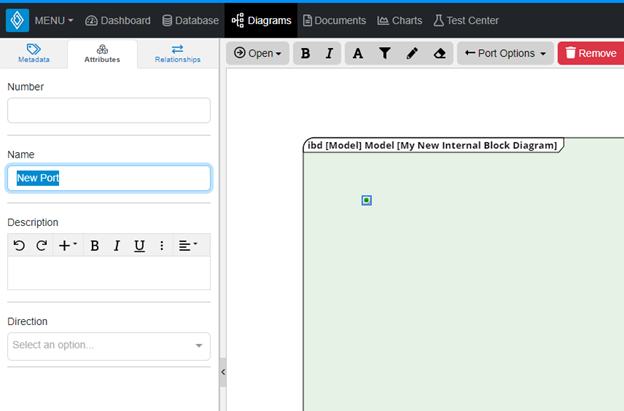
3. Release the left mouse button while over the diagram canvas to drop the new ‘Port’ and add it to the diagram. The ‘Port’ will automatically snap to the nearest invisible grid intersection. Notice the ‘Port’ stays selected once it has been dropped. Since it is selected, the toolbar changes to include buttons for functions that can be used on the construct. The sidebar also changes to include additional ‘Metadata,’ ‘Attributes,’ and ‘Relationships’ tabs.

4. Once added to the diagram, enter a meaningful ‘Name’ for your new ‘Port’ via the ‘Attributes’ tab of the left sidebar (focused automatically for convenience).

5. Click the ‘Save’ button located on the toolbar to persist your changes to your project’s database.
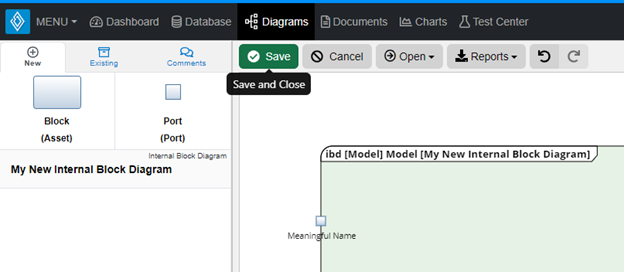
Adding a Port to a Block
1. Within an ‘Internal Block Diagram,’ click the ‘Port’ icon in the ‘New’ tab of the left sidebar and continue to hold down the left mouse button.
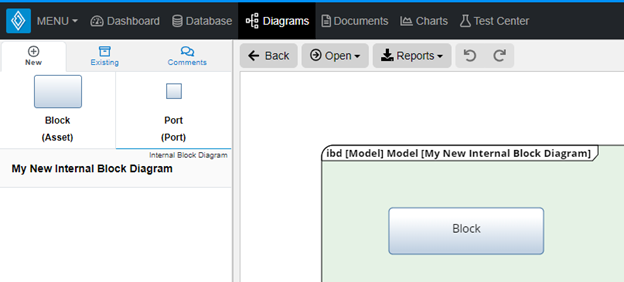
2. Drag the ‘Port (Port)’ icon over to the destination ‘Block’ of your choice.

3. When the ‘Block’ box highlights green, release the left mouse button to drop the new ‘Port’ and add it to the diagram. The ‘Port’ will be added to the border of the ‘Block’ construct.
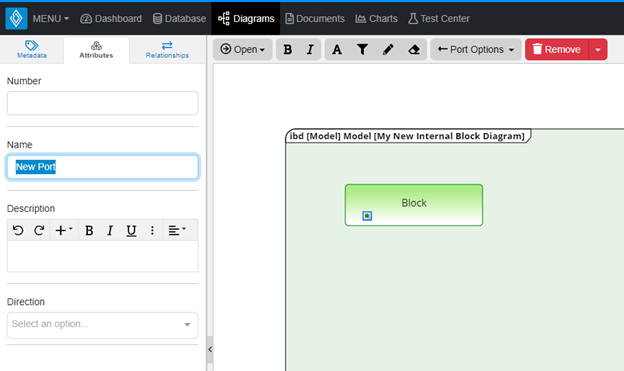
Notice that the ‘Port’ name remains highlighted in the New Port window under the Attribute tab.
4. Once added to the diagram, enter a meaningful ‘Name’ for your new ‘Port’ via the ‘Attributes’ tab of the left sidebar (focused automatically for convenience).

5. Click the ‘Save’ button located on the toolbar to persist your changes to your project’s database.

* Note: The above process describes using the ‘New’ tab of the left sidebar, which automatically generates a new entity to represent each new diagram construct. If you would like to reuse existing entities from your database to represent a new construct, use the ‘Existing’ tab instead.
Adding a Connector
A ‘Connector’ construct can be added to an ‘Internal Block Diagram‘ via drag-and-drop.
Adding a Connector Between Blocks
The example used below connects two ‘Block’ constructs with a ‘Connector’ construct.
-
Within an ‘Internal Block Diagram,’ select the ‘Block’ you would like connected to another ‘Block.’
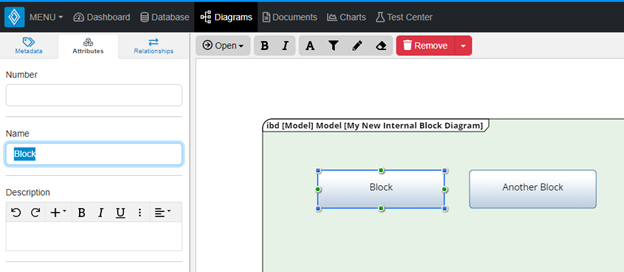
-
Click the green circle and continue to hold down the left mouse button.
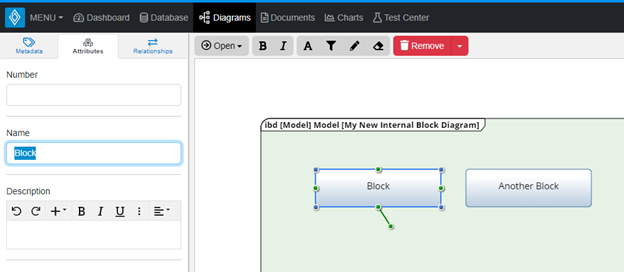
-
Drag the green circle over to another ‘Block’ of your choice.
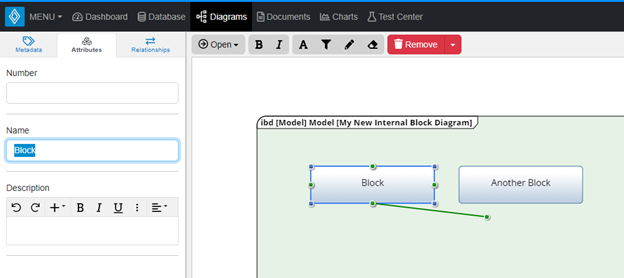
-
When the other ‘Block’ box highlights green, release the left mouse button to drop the new ‘Connector’ and add it to the diagram.

Notice the ‘Connector’ stays selected once it has been dropped. Since it is selected, the toolbar changes to include buttons for functions that can be used on the construct. The sidebar also changes to include additional ‘Metadata,’ ‘Attributes,’ and ‘Relationships’ tabs.
-
Once added to the diagram, enter a meaningful ‘Name’ for your new ‘Connector’ via the ‘Attributes’ tab of the left sidebar (focused automatically for convenience).
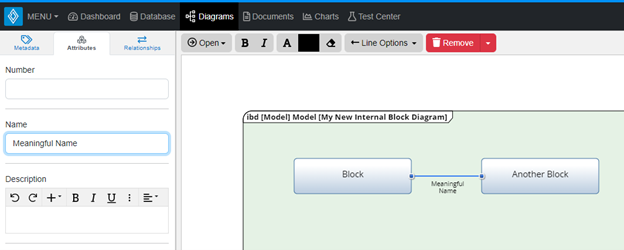
- Click the ‘Save’ button located on the toolbar to persist your changes to your project’s database.

Adding a New Connector Between Ports
The example used below connects two ‘Block’ constructs with a ‘Connector’ construct via two ‘Port’ constructs.
-
Within an ‘Internal Block Diagram,’ select the ‘Port’ you would like connected to another ‘Port.’

-
Click the green circle and continue to hold down the left mouse button.
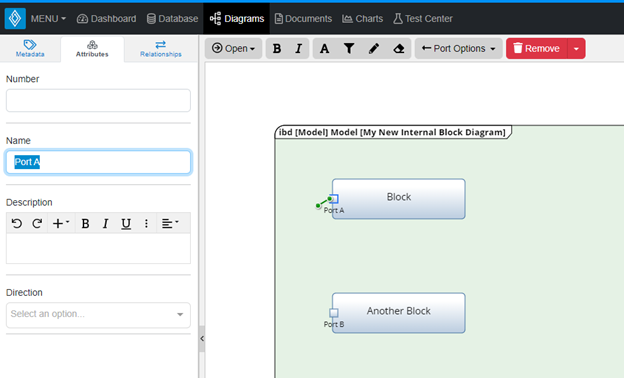
-
Drag the green circle over to another ‘Port’ of your choice.
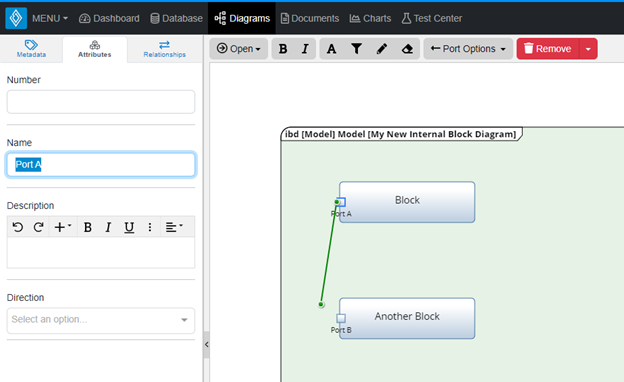
-
When the other ‘Port’ box highlights green, release the left mouse button to drop the new ‘Connector’ and add it to the diagram.
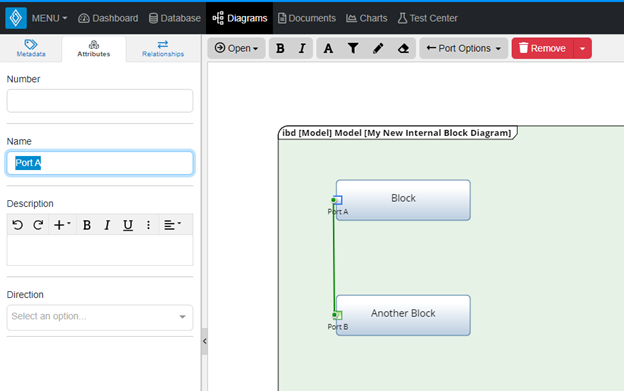
Notice the ‘Connector’ stays selected once it has been dropped.
-
Once added to the diagram, click on the line label and enter a meaningful ‘Name’ for your new ‘Connector’ via the ‘Attributes’ tab of the left sidebar (focused automatically for convenience).
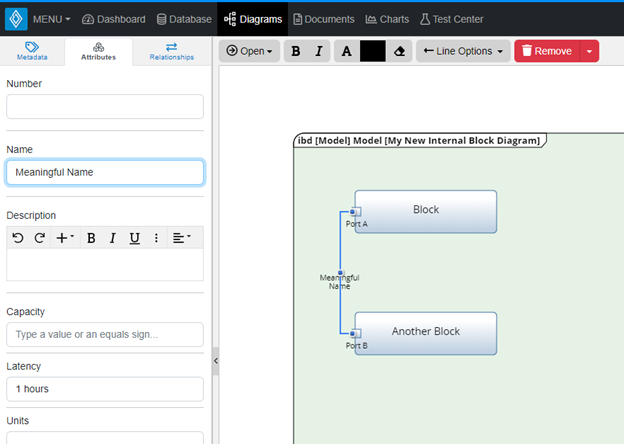
-
Click the ‘Save’ button located on the toolbar to persist your changes to your project’s database. This will create a connects to relationship from port to port.

Removing a Construct
A construct can be easily removed from an ‘Internal Block Diagram‘.
- Within an ‘Internal Block Diagram,’ select the construct you wish to remove. This will make the toolbar appear with applicable functions which can be used on the selected construct.
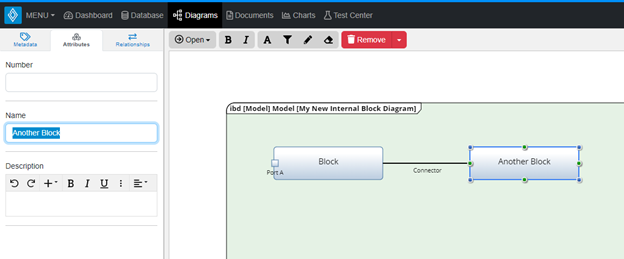
- Click the ‘Remove’ button to remove the construct from the diagram (as the default action).
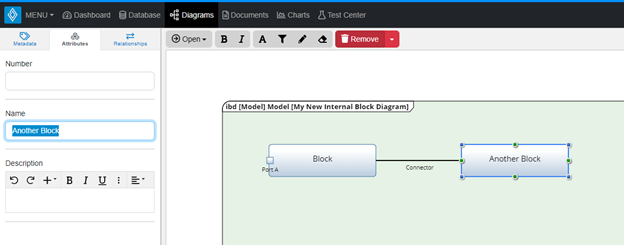
* Note: The ‘Remove’ button also includes a drop-down menu where you can select ‘Delete from Database’ or the default option of ‘Remove from Diagram.’
Nesting a Block
A ‘Block’ construct can be nested inside another existing ‘Block’ construct within an ‘Internal Block Diagram’ via drag-and-drop.
1. Within an ‘Internal Block Diagram,’ click the ‘Block’ icon in the ‘New’ tab of the left sidebar and continue to hold down the left mouse button.
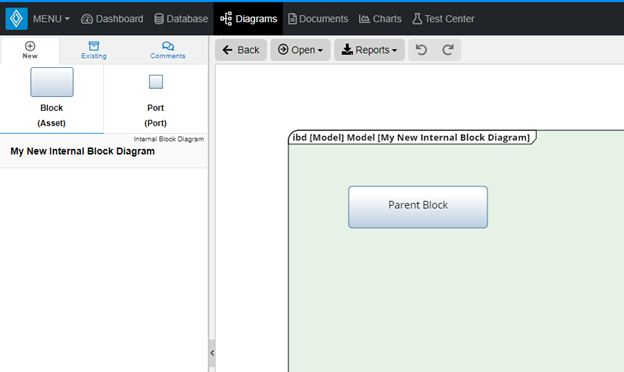
2. Drag the new ‘Block’ construct over the parent ‘Block’ construct until it highlights green.
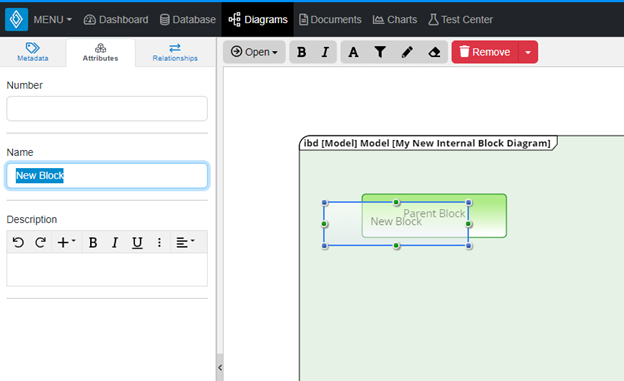
3. Drop the new ‘Block’ construct into the parent ‘Block’ construct, which will envelop the new ‘Block’ construct to visualize the parent-child relationship.
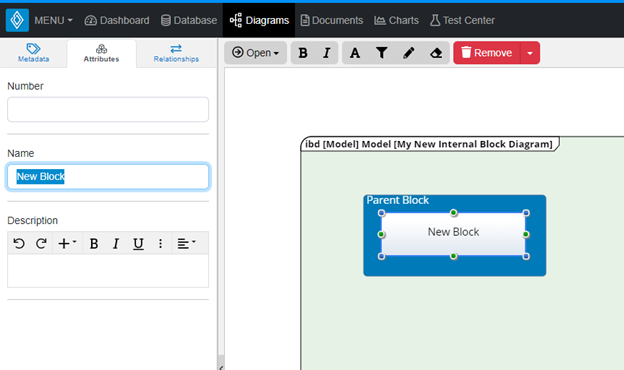
4. Click the ‘Save’ button located on the toolbar to persist your changes to the project’s database.
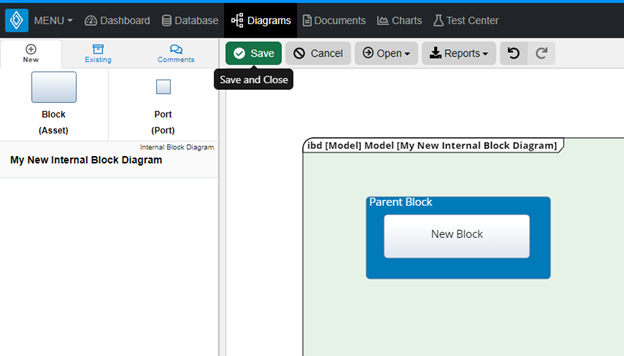
Nesting a Port
A ‘Port’ construct can be nested inside another existing ‘Port’ construct within an ‘Internal Block Diagram’ via drag-and-drop.
1. Within an ‘Internal Block Diagram’, click the ‘Port’ icon in the ‘New’ tab of the left sidebar and continue to hold down the left mouse button.
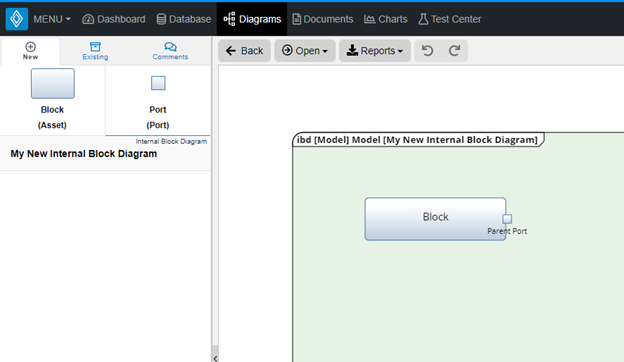
2. Drag the new ‘Port’ construct over the parent ‘Port’ construct until it highlights green.

3. Drop the new ‘Port’ construct into the parent ‘Port’ construct, which will envelop the new ‘Port’ construct to visualize the parent-child relationship.
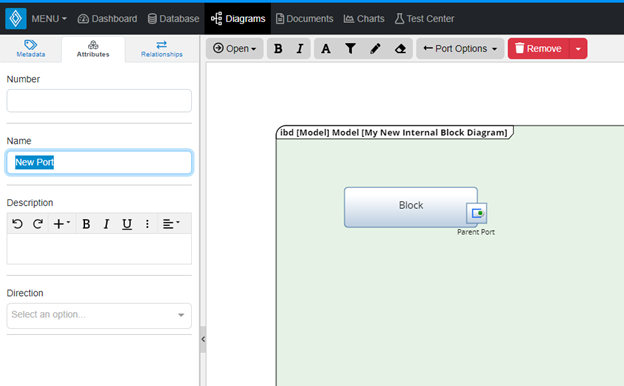
4. Click the ‘Save’ button located on the toolbar to persist your changes to the project’s database.
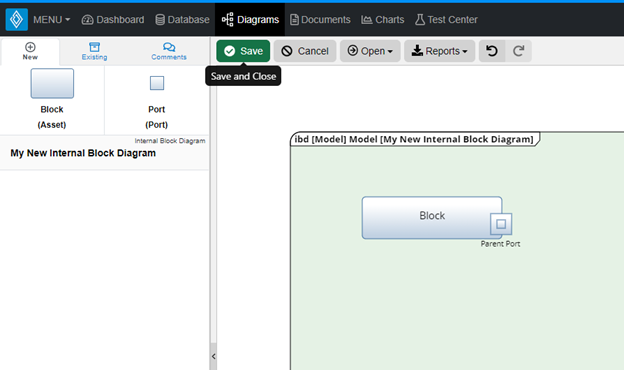
Tutorial Video
To continue learning about SysML Diagrams, Click Here.
(Next Article: Internal Block Diagram Modifications & Settings)
